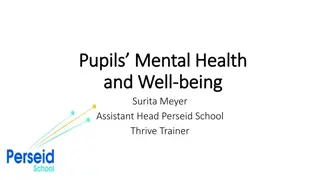Mental Health and Psychological Support in Emergencies Framework
A framework for mental health and psychological support in radiological and nuclear emergencies was discussed at workshops in Jakarta and Roskilde. Global action has been ongoing since 1992 through the IASC, focusing on addressing mental health needs during emergencies and crisis situations. Terminology guidelines aim to provide a common language for professionals and organizations involved in psychological support and mental health services.
Download Presentation

Please find below an Image/Link to download the presentation.
The content on the website is provided AS IS for your information and personal use only. It may not be sold, licensed, or shared on other websites without obtaining consent from the author.If you encounter any issues during the download, it is possible that the publisher has removed the file from their server.
You are allowed to download the files provided on this website for personal or commercial use, subject to the condition that they are used lawfully. All files are the property of their respective owners.
The content on the website is provided AS IS for your information and personal use only. It may not be sold, licensed, or shared on other websites without obtaining consent from the author.
E N D
Presentation Transcript
A NEW FRAMEWORK FOR MENTAL HEALTH AND PSYCHOLOGICAL SUPPORT IN RADIOLOGICAL AND NUCLEAR EMERGENCIES Jakarta, Indonesia, 26 27 November 2018 mhGAP to accelerate implementation of Regional workshop Fahmy Hanna and Zhanat CARR WHO Headquarters Olvido Guzman Matthias Zahringer NEA/OECD Wolfgang Weiss Germany BfS, Germany The 5th NERIS Workshop Roskilde, Denmark, 03-05 April 2019
No Health without Mental Health Health is a state of complete physical, mental and social well-being and not merely the absence of disease or infirmity (WHO definition, 1948) Mental health is defined as a state of well-being in which every individual realizes his/her own potential, can cope with stressful situations, can work productively and fruitfully, and is able to make a contribution to her or his community. 2|
Global action on addressing Mental Health and Psychological Support in Emergencies Since 1992, the Interagency Standing Committee (IASC) a unique forum that has a primary role for coordination, policy development and decision-making with regard to humanitarian emergencies, involving the key UN and non-UN partners. The IASC launched a Mental Health Global Action Plan (mh-GAP) IASC 2007 Guidelines on Mental Health and Psychologial Support (MHPSS) in Emergency Settings were developed with input from UN agencies, NGOs and academia. The Guidelines help to plan, establish and coordinate a set of minimum multi-sectoral responses to protect, support and improve people s mental health and psychosocial wellbeing in the midst of an emergency. https://interagencystandingcommittee.org/mental-health-and-psychosocial-support-emergency-settings
IASC Guidelines framework terminology Conventional use of the term psychological support varies and implies different things for different users: For health professionals: non-clinical interventions for people with mental disorders (including transient psychological conditions, outside of clinical psychiatry and mental disorders) For others (civil protection, social/community services, etc): any non-clinical support for any person with/ without disorder (e.g. creating child friendly spaces) Lack of common language => Confusion, misuse of guidance IASC uses inclusive approach for a composite definition covering both aspects: protecting or promoting psychosocial well-being through providing Psychological Support and preventing or treating Mental Health disorders MHPSS a commonly used abbreviation by the IASC members and associated/relevant professional communities
Contributing factors to MHP consequences of nuclear emergencies Fear of radiation due to the lack of knowledge and information Exposure to stress related to the implementation of protective actions Challenges of risk communication often under unclear circumstances Social stigma and discrimination of the evacuees Photo: Asahi Shimbun www.asahi.com Evacuation, relocation and long-term displacement Social and economic consequences
Psychosocial consequences of nuclear emergencies Psychosocial impact may outweigh the radiological consequences of nuclear emergencies. It was found to be the largest after Chernobyl accident (WHO, 2006) and persisted for decades. In 1986, the socio-economic impact of the accident itself was exacerbated by the disintegration of Soviet Union. In addition, the lack of proper risk communication, no access to information and to lack of community s engagement in the decision making, as well as stigmatization of the affected persons and participants of the long-term medical monitoring, have contributed to the over-all anxiety of the affected population. Medical follow-up was linked to small social benefits, but also reinforced the stigmatization and affected people's lives and contributing to the psycho-social consequences of the accident 6
Psychosocial impact of 2011 Fukushima Daiichi NPP accident Loss of homes, jobs, and the rupture of social fabric of the affected communities has caused a tremendous stress to the affected people. In addition to the stress related to evacuation and relocation, a social stigma is attached to evacuees and residents of the affected areas. Parents of affected children are reported to have recurring anxiety about the health and future of their children. Evacuees, TEPCO workers, and public service personnel affected by the Fukushima nuclear accident were reported to have a high level of anxiety, depression, panic attacks, PTSD, burn out, higher incidence of suicide, etc.
Non-radiological impact of RN emergencies on health - call for broadening the scope of preparedness 2018
Mental Health impact of Chemical, Biological, and Nuclear emergencies WHO report Mental health of populations exposed to biological and chemical weapons (2005) is undergoing revision https://goo.gl/Mo7LZE in addition, accompanying derivative information products are being developed For nuclear emergencies, a similar approach is being followed in order to adopt the mhGAP guidelines to a nuclear emergency settings.
Intervention pyramid (IASC 2007) Clinical mental health care by psychiatrists or primary health care specialists Clinical services Targeted psychosocial support Basic emotional and practical support to vulnerable groups, selected individuals and families by health care professionals Activating social networks, linking with community leaders and support groups Community and family support Advocacy for good humanitarian practice: basic services that are safe, socially appropriate and that protect dignity Social considerations in basic services and security
Integration of MHPS approach in nuclear emergencies preparedness and response (EPR) PREPAREDNESS Public mental health policy and mapping of existing resources Risks and vulnerability analysis Coordination plan Development of a MHPSS protocols and contingency plan for emergencies and disasters Prepare for needs assessments, monitoring, and evaluation of response Human resource management and staff support Develop a communication strategy; including a media and a social media outreach strategy
Integration of MHPS approach in nuclear emergencies preparedness and response (EPR) EMERGENCY PHASE Communication and coordination between responding parties Emergency risk communication Support to evacuated and over-exposed Arrangements for safe mourning for deceased (and for managing contaminated remains) Community intervention and mobilization Mental health interventions MHPS for emergency responders
Integration of MHPS approach in nuclear emergencies preparedness and response (EPR) POST EMERGENCY PHASE - COMMUNITY INTERVENTIONS Self help groups Community coping strategies Rebuilding trust in social structures Re-establishing cultural and religious events Help to families and children to understand the risks Individual case management Mitigation of economic impact
Integration of MHPS approach in nuclear emergencies preparedness and response (EPR) POST EMERGENCY PHASE MENTAL HEALTH INTERVENTIONS Building back through improved and adopted policies (lessons learnt) Training general health workers and community workers and monitor results Educating the affected communities Establishing referral system Ensuring treatment access for those with clinical mental health conditions Linking mental health and social care services Setting up long-term mental health effects research, if feasible
WHO-NEA cooperation on non-radiological health effects of radiation emergencies (1) Working Party on Nuclear Emergency Matters (WPNEM) of the NEA/OECD and WHO agreed to develop a joint project addressing psycho-social impact on radiological and nuclear emergencies A two-phase project started in 2018 Year 1: Development of a policy framework document on application of WHO guidelines on mental health to radiation emergencies (WHO-led task) Year 2: Development of practical arrangements to support emergency response planners and managers to provide tools for efficient mitigation of psychosocial impact (WPNEM-led task)
WHO-NEA cooperation on non-radiological health effects of radiation emergencies (2) Started in 2018 from the discussion at the WPNEM meeting in Paris Agreed on the roles, scope and time-frame WHO Department of Mental Health and Brain Disorders developed the first draft by December 2018 Preliminary review done in Jan-March 2019 Peer-review to be done in April-June 2019 to get feedback of the relevant stakeholders, expert networks and professional societies Draft will be finalized by Sept 2019 by WHO Joint WHO-NEA-BfS workshop planning is on the way
WHO-REMPAN Webinar on Mental Health (MH) impact of Nuclear Emergencies 15 April 2019 13:00 to 14:30 (Paris time UTC+2) MH and nuclear emergencies: what to expect, surveillance, triage and coordinating care (R. Ursano MH sequelae in 1945 atomic bomb survivors in Hiroshima and Nagasaki (K. Kodama) MH impact of the 1986 Chernobyl accident (J. Havenaar) Psychological consequences of the 2011 Fukushima accident (M. Maeda) WHO-IASC 2007 Guidelines on MH Psychosocial Support (MHPSS) in Emergency Settings and its application to nuclear emergency settings (F. Hanna) To connect via Webex: https://goo.gl/MbNmT9
Summary Non-radiological health consequences prevail over direct impact of radiation, mental health and psycho-social impact was reported to be largest among those affected by nuclear accidents in the past Experiences from past nuclear accidents and other types of emergencies needs to be taken into account when developing policies an tools Cross-sector multi-disciplinary policies and strategies and decision-support tools are needed to address MHPS needs of populations at all stages of an emergency: in planning, responding and recovering from an emergency.























